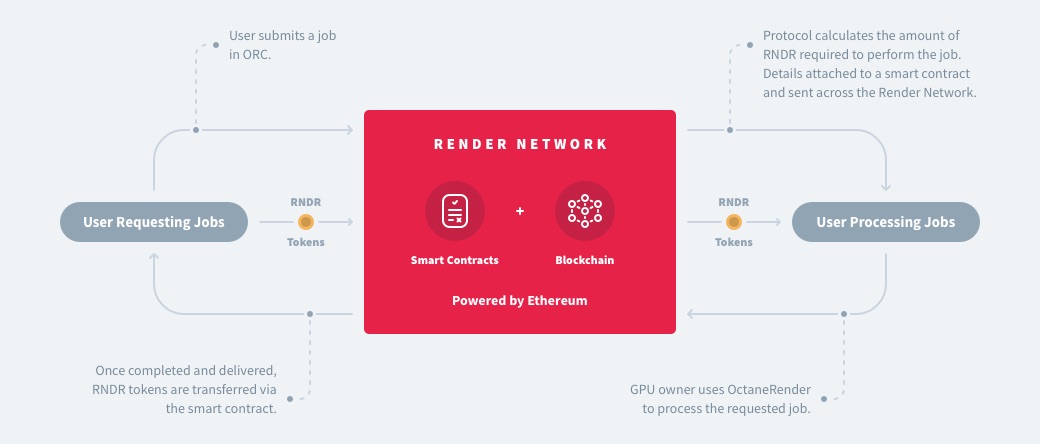Rendering the Metaverse
Distributed GPU rendering on the blockchain
Advancing the Next Generation of Rendering and AI Technology
Advancing the Next Generation of Rendering and AI Technology

The Render Network is the first decentralized GPU rendering platform, empowering artists to scale GPU rendering work on-demand to high performance GPU Nodes around the world. Through a blockchain marketplace for idle GPU compute, the network provides artists the ability to scale next generation rendering work at fractions of the cost and at orders of magnitude increases in speed when compared to the centralized GPU cloud.
Launched in 2017, the Render Network is built to provide a platform for a wide array of computation tasks - from basic rendering to artificial intelligence - which are facilitated swiftly and efficiently in a blockchain-based peer-to-peer network, free from error or delay, while ensuring secure property rights.
OctaneRender® is the world’s first and fastest GPU-accelerated, unbiased, physically correct renderer. Octane uses the graphics card in your computer to render photo-realistic images super fast. With Octane’s parallel compute capabilities, you can create stunning works in a fraction of the time.
OTOY’s Academy Award®-winning technology is used by leading visual effects studios, artists, animators, designers, architects, and engineers, providing unprecedented creative freedom, new levels of realism, and new economics in content creation and distribution powered by the cloud.
OTOY® was founded in 2008 by Jules Urbach, Alissa Grainger and Malcolm Taylor. Since then, the company has grown to over 60 employees across four offices with headquarters in Los Angeles, CA.
The Render Network creates a much more efficient, powerful, and widely-scalable rendering network.
The Render Network creates a much more efficient, powerful, and widely-scalable rendering network.
The Render Network is designed to connect users looking to perform render jobs with people who have idle GPUs to process the renders. Owners would connect their GPUs to the Render Network in order to receive and complete rendering jobs using OctaneRender. Users would send RNDR to the individual performing the render work and OTOY would receive a small percentage of RNDR for facilitating the transaction and running the Render Network.
Once they’ve registered their idle GPUs on the Render Network, these GPU owners become “Node Operators” and are able to earn RNDR Tokens. They do this by accepting jobs from users in need of rendering work, known as “Creators”, who send their files to the Render Network, where they are assigned to Operators. the Render Network receives a small percentage of the RNDR paid out in order to maintain the network and facilitate the transaction.
Authoring and publishing state-of-the-art graphics is an immense challenge that is growing each day. The future demand for advanced rendering will lead to even more complexity and require higher resolution and more interactivity.
Making next generation 3D rendering widely accessible for the content demands of immersive media requires exponential increases in computing scale that is only possible through a decentralized global network.
Most GPUs sit idle when not in use locally. Meanwhile, artists and developers struggle scale cloud rendering and computing work. The Render Network provides a two-sided marketplace for efficiently coordinating global GPU compute supply and demand.
Decentralized GPU resources are wasted in ‘proof of work’ cryptocurrency mining. Render unlocks the full productive potential of decentralized GPU computing to power next generation 3D content creation and artificial intelligence.
Next generation immersive media and artificial intelligence require new forms of authentication and provenance. The Render Network provides granular digital rights management through on-chain traceability of a node based render graph.
The Render Network is the first network to transform the power of GPU compute into a decentralized economy of connected 3D assets.
Please Read the Whitepaper for More Details
Blockchain’s widespread adoption was the key to realizing the Render Network. Instead of GPUs being used to only mine currencies, the network uses their intrinsic function to render and leverage the features of the blockchain: network, incentives and trust.
Media
Industry
Augmented Reality
Mixed Reality
Gaming
Medical
Virtual Reality


Ethereum’s widespread adoption was the key to realizing our vision. Instead of GPUs being used to only mine currencies, we use their intrinsic function to render and leverage the features of the blockchain: network, incentives and trust.

Head of Blockchain

Chief Technology Officer

Director of Strategy

Project Manager

Product Manager

Blockchain Developer

Developer

Developer

3D Artist & Success Manager
Jules sets the strategic vision for OTOY, and is the chief architect of the company’s technology roadmap. Widely hailed as a pioneer in computer graphics, streaming and 3D rendering with over 25 years of industry experience.
He made his first game, at 18, and went on to make the web’s first 3D video game platform and licensed the software to Macromedia, Disney, Warner Brothers, Nickelodeon, Microsoft, Hasbro and AT&T.
His life’s work has been to revolutionize 3D content capture, creation and delivery.
We got your email, and well be in touch.